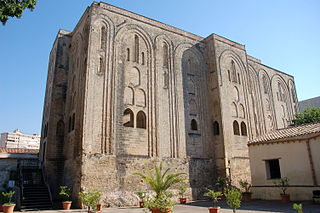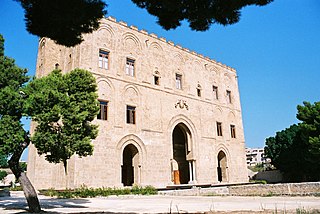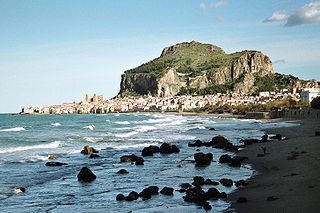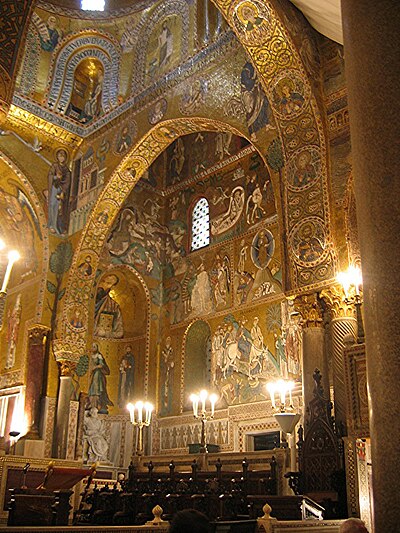
Palermo is a city in southern Italy, the capital of both the autonomous region of Sicily and the Metropolitan City of Palermo, the city's surrounding metropolitan province. The city is noted for its history, culture, architecture and gastronomy, playing an important role throughout much of its existence; it is over 2,700 years old. Palermo is in the northwest of the island of Sicily, by the Gulf of Palermo in the Tyrrhenian Sea.

Monreale is a town and comune in the Metropolitan City of Palermo, in Sicily, southern Italy. It is located on the slope of Monte Caputo, overlooking the very fertile valley called "La Conca d'oro", a production area of orange, olive and almond trees, the produce of which is exported in large quantities. The town, which has a population of approximately 39,000, is about 7 kilometres inland (south) of Palermo, the regional capital.

The term Norman architecture is used to categorise styles of Romanesque architecture developed by the Normans in the various lands under their dominion or influence in the 11th and 12th centuries. In particular the term is traditionally used for English Romanesque architecture. The Normans introduced large numbers of castles and fortifications including Norman keeps, and at the same time monasteries, abbeys, churches and cathedrals, in a style characterised by the usual Romanesque rounded arches and especially massive proportions compared to other regional variations of the style.

The province of Palermo was a province in the autonomous region of Sicily, a major island in Southern Italy. Its capital was the city of Palermo. On 4 August 2015, it was replaced by the Metropolitan City of Palermo.

Palermo is one of the major cities of Italy, and the historical and administrative capital of Sicily.

The Cuba is a recreational palace in the Sicilian city of Palermo, originally part of the Sollazzi Regi group of Norman palaces. It was built in 1180 by William II of Sicily in his Royal Park, together with an artificial lake. The name Cuba derives either from its cubical form, or the Arabic Qubba, "dome". It is an imitation of the Zisa palace. In July 2015 it was included in the UNESCO Arab-Norman Palermo and the Cathedral Churches of Cefalù and Monreale World Heritage Site.

The Zisa is alternatively listed as either a castle or palace, and located in the western area of Palermo, region of Sicily, Italy. The edifice was begun around 1165 by Arab craftsman under the rule of the Norman conqueror of Sicily, king William I of Sicily. It was not finished until 1189, under the rule of William II. It is presently open to the public for tours.

The Palatine Chapel is the royal chapel of the Norman Palace in Palermo, Sicily. This building is a mixture of Byzantine, Norman and Fatimid architectural styles, showing the tricultural state of Sicily during the 12th century after Roger I and Robert Guiscard conquered the island.

The Church of St. Mary of the Admiral, also called Martorana, is the seat of the Parish of San Nicolò dei Greci, overlooking the Piazza Bellini, next to the Norman church of San Cataldo, and facing the Baroque church of Santa Caterina in Palermo, Sicily, southern Italy.
Walter Ophamil or Offamil, italianised as Gualtiero Offamiglio or Offamilio from Latin Ophamilius, was the archdeacon of Cefalù, dean of Agrigento, and archbishop of Palermo (1168–1191), called "il primo ministro", the first minister of the crown. He came to Sicily with Peter of Blois and Stephen du Perche at the direction of Rotrou, Archbishop of Rouen, cousin of Queen Margaret of Navarre, originally as a tutor to the royal children of William I of Sicily and Margaret. His mother was Bona, a patron of the Abbey of Cluny and a devota et fidelis nostra of the king in 1172. His father is unknown. From his name he was long thought to be an Englishman but this interpretation is now rejected in favour of ophamilius referring to Walter as William II's protofamiliaris, the senior confidant of the king in his royal household, the familiaris regis.

The Cathedral of Cefalù is a Roman Catholic basilica in Cefalù, Sicily. It is one of nine structures included in the UNESCO World Heritage Site known as Arab-Norman Palermo and the Cathedral Churches of Cefalù and Monreale.

San Giovanni degli Eremiti is an ancient former monastic church located on Via Benedettini #19 in the ancient quarter of Albergaria of the city of Palermo, region of Sicily, Italy. It is about two blocks south from the Palazzo dei Normanni, adjacent to the church of San Giorgio in Kemonia. While the interior is virtually devoid of decoration or furnishings, the red Norman-Byzantine domes, the medieval cloister ruins, and garden make this small church a symbol of ancient Palermo.

The term Norman–Arab–Byzantine culture, Norman–Sicilian culture or, less inclusively, Norman–Arab culture, refers to the interaction of the Norman, Byzantine Greek, Latin, and Arab cultures following the Norman conquest of the former Emirate of Sicily and North Africa from 1061 to around 1250. The civilization resulted from numerous exchanges in the cultural and scientific fields, based on the tolerance shown by the Normans towards the Latin- and Greek-speaking Christian populations and the former Arab Muslim settlers. As a result, Sicily under the Normans became a crossroad for the interaction between the Norman and Latin Catholic, Byzantine–Orthodox, and Arab–Islamic cultures.

Cefalù, classically known as Cephaloedium, is a city and comune in the Italian Metropolitan City of Palermo, located on the Tyrrhenian coast of Sicily about 70 km (43 mi) east of the provincial capital and 185 km (115 mi) west of Messina. The town, with its population of just under 14,000, is one of the major tourist attractions in the region. Despite its size, every year it attracts millions of tourists from all parts of Sicily, and also from all over Italy and Europe. It is one of I Borghi più belli d'Italia.

The Sicilian Regional Assembly is the legislative body of Sicily. While it has a long history as an autonomous entity, the modern Region of Sicily was established by Royal Decree on 15 May 1946, before the Italian Republic. The Regional Assembly has the widest legislative power in Italy and is the only regional assembly to have the title of "parliament" whose members are called "deputies" as are those in Rome. Seventy deputies are elected every five years in the nine provinces.

The Sicilian Parliament was the legislature of the Kingdom of Sicily.

Arab-Norman Palermo and the Cathedral Churches of Cefalù and Monreale is a series of nine religious and civic structures located on the northern coast of Sicily dating from the era of the Norman Kingdom of Sicily (1130-1194): two palaces, three churches, a cathedral, and a bridge in Palermo, as well as the cathedrals of Cefalù and Monreale. They have been designated together as a UNESCO World Heritage Site. This dedication took place in 2015.

Palermo, main city of Sicily, has a big heritage of churches which ranges from the Arab-Norman-Byzantine style to the Gothic and the Baroque styles. In particular, the list includes the most important churches of the historic centre divided by the four areas of Kalsa, Albergaria, Seralcadi and Loggia.

The Maredolce Castle, also called Favara Palace, is a medieval building of Palermo. During the Siculo-Norman age it represented one of the "Solatii Regii", pleasure palaces, of the Kings of Sicily. It is located within Favara Park, in the neighbourhood of Brancaccio.

The following outline is provided as an overview of and topical guide to Palermo:

























